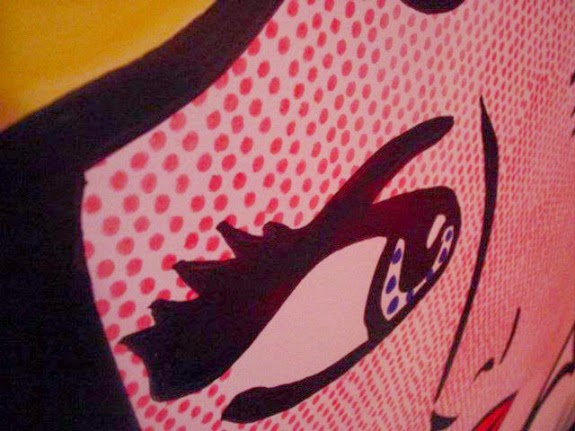Benjamin Day is a printer and Illustrator, whom the Ben-day printing is named after. The process of the Ben-day printing is very similar to pointillism. It has a technique of dot placement which varies depending on the effect needed. The dots could be closely spaced, widely spaced or overlapping.
To create a
pink colour for example Magenta dots are printed widely spaced.
Magenta, Yellow, black and cyan were used to create secondary colours, such as green, orange and purple. This was the four colour process of ben-Day, used by pulp comics in the 50's and 60's.
Ben-day
dots are different from half tone dots in a way that Ben-Day dots never vary in size and distribution of specific area. Transparent overlay sheet bought by the artist is used to apply the dots to the drawing. These sheets gave the artist a great range of tone for his work as the sheets were available in a wide variety of size and dot distribution. These were cut as desired into the overlay material for example shadow, background or surface treatment and it is rubbed using a burnished, onto the specific areas of the drawing.
The areas of Ben-Day overlay provided the painting plate with tonal shading, especially when it is photographically reproduced as a line-cut for letter press printing.
Drowning
Girl presents
"a young woman who seems to have cried herself in a river. Literally
drowning in emotion," The scene looks clear that she has been hurt and
crying. Exaggerated to a point that the tears are turned into a sea.
Lichtenstein style, the sad
female is presented "in a suspended state of distress”. She looks like
resting on the wave and water instead of floating and swimming which shows a
mixture of "eroticism and final
resting place".
The waves seem to be continuously moving around her. The painting shows a lot of emotions such as
sadness, darkness, loneliness and fear.
Roy Lichtenstein was the example of an artist whom, the Ben-day dots were considered a trademark of. Especially in his interpretations of contemporary comic book on magazine images. He enlarge and exaggerated them in many of his sculptures and paintings. Other artists and graphic designers have used enlarged Ben-Day in print media.
Lichtenstein used other techniques and material, apart from Ben-Day dots, as his media. Other techniques used by him were;
Gesso, which is usually made using a ready made mixture of a Paris and glue plaster. The acrylic version of this technique is used by todays artists. Apart from giving it a uniform while appearance, it's purpose is to prevent the canvas from absorbing to much water.
Lichtenstein used other techniques and material, apart from Ben-Day dots, as his media. Other techniques used by him were;
Gesso, which is usually made using a ready made mixture of a Paris and glue plaster. The acrylic version of this technique is used by todays artists. Apart from giving it a uniform while appearance, it's purpose is to prevent the canvas from absorbing to much water.
Lichtenstein also liked to use Magna, a specific type of acrylic, because it could be easily removed using a spirit and out of most of the water based acrylic is the one that shows the best colour.
For
a slik-screening print, an artist puts a
stencil on a stretched piece of silk then puts a paper underneath the silk. He
then draws the ink across the top of the silk by using a squeegee, a type of
rubber and wood paddle. This process is also known as Serigraph.
A
woodcut is when ink is applied to a carved block of wood and through this
process a print is created.
These two pictures resulting of a commentary inspired by comic
style. On the right, one can already notice it’s Lichtenstein work. And the other is by Tony Abruzzo.
Roy Lichtenstein is the most famous pop artist during the sixties,
especially well known for his comic-strip paintings of his comic books. Both looks
very similar. Colours are bold, lines are dark.
He used the woman, in “Run for Love” to capture the illusion that
she’s about to drown and a guy looks to be on the way to save her.
On the other hand, Abruzzo created the style of the background
same as Lichtenstein. One can see a man who is being chased “By the bad guy”
for what seems to be a copy of something held tightly in his hands.
Both of the comic pictures have use of thick lines, bold colours,
thought bubbles and boxed captions which were often included in comic books.
Nowadays this Be-day effect
technique is still in use in the form of
Colour Halftone filter found in Adobe Photoshop.
Maggie Burgan. 2009.
Roy Lichtenstein Ben day dot technique. [ONLINE] Available at : http://www.awdsgn.com/classes/fall09/webI/student/trad_mw/burgan/final_project/pages/technique.html
[Accessed 26 May 14 ]
Scott Edelman. 2013. Another reason I love Dave Gibbons (and continue to hate Roy Lichtenstein). [ONLINE] Available at: http://www.scottedelman.com/2013/04/12/another-reason-i-love-dave-gibbons-and-continue-to-hate-roy-lichtenstein/. [Accessed 19 June 14].
Melissa Evans. 2014. Pop Art Inspired by Lichtenstein . [ONLINE] Available at:http://www.melissaevans.com/tutorials/pop-art-inspired-by-lichtenstein. [Accessed 19 June 14].
Scott Edelman. 2013. Another reason I love Dave Gibbons (and continue to hate Roy Lichtenstein). [ONLINE] Available at: http://www.scottedelman.com/2013/04/12/another-reason-i-love-dave-gibbons-and-continue-to-hate-roy-lichtenstein/. [Accessed 19 June 14].
Melissa Evans. 2014. Pop Art Inspired by Lichtenstein . [ONLINE] Available at:http://www.melissaevans.com/tutorials/pop-art-inspired-by-lichtenstein. [Accessed 19 June 14].


































